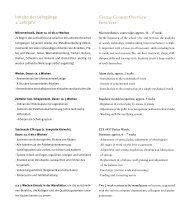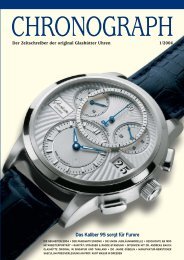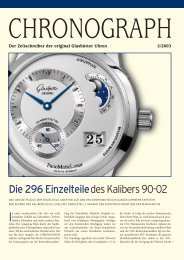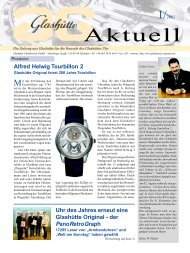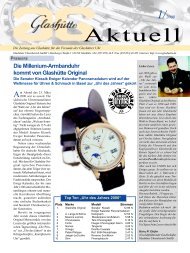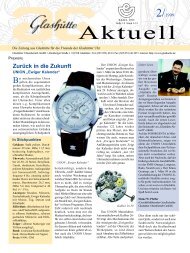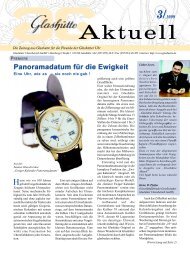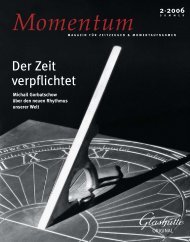2009 Momentum - Glashütte Original
2009 Momentum - Glashütte Original
2009 Momentum - Glashütte Original
You also want an ePaper? Increase the reach of your titles
YUMPU automatically turns print PDFs into web optimized ePapers that Google loves.
16 <strong>Momentum</strong> 1· <strong>2009</strong><br />
Moments Universal time<br />
UTC + 4 | Georgia<br />
South of the Greater Caucasus, you<br />
have to put your watch four hours<br />
ahead<br />
and the left-hand clock showed the time in Paris, which was 20<br />
minutes behind Bern – and the trains leaving Geneva for Paris ran<br />
according to Paris time. So it was clear that the world’s railways<br />
would benefit tremendously if the times could be standardized.<br />
Fleming’s proposal was that the world should be divided into<br />
large equal-sized sections – time zones – within which a uniform<br />
time would apply.<br />
Five years later, in October 1884, Fleming’s wish was<br />
granted. Representatives from 25 nations met at the Inter national<br />
Meridian Conference in Washington D.C. to determine the Prime<br />
Meridian – an imaginary line running from the North to the South<br />
Pole that would serve as the starting point for all the other equidistant<br />
meridians circling the planet. During the conference, a victor<br />
emerged from among the five proposed candidates for the Prime<br />
Meridian. This was the Greenwich Meridian, named after the Royal<br />
Greenwich Observatory on the outskirts of London. In many<br />
respects, the Greenwich Meridian seemed the obvious choice as<br />
it had long been the reference meridian for celestial navigation<br />
and nautical maps. Since 1880 it had also decided the official time<br />
in the United Kingdom – Greenwich Mean Time, which was now<br />
to become the basis for calculating the time across the whole planet.<br />
UTC -4 | Barbados<br />
Time moves at a different pace on<br />
the Lesser Antilles – four hours behind<br />
UTC<br />
UTC + 3 | Moscow<br />
Muscovites are getting ahead of<br />
Londoners – by three hours<br />
UTC -5 | Toronto<br />
When we’re gulping down our lunch<br />
in Europe, residents of Canada’s<br />
biggest city are still lingering over<br />
breakfast<br />
UTC +2 | Egypt<br />
The pyramids are timeless – so who<br />
cares about a couple of hours here<br />
or there?<br />
UTC + 1 | Berlin<br />
Modern Berlin is ahead of its time?<br />
Well, it’s one hour ahead of UTC, at<br />
least!<br />
After agreement had been reached on where to locate the Prime<br />
Meridian, the earth could be divided up into 24 equally sized time<br />
zones, defined as the area between two lines of longitude 15°<br />
apart. The time in each zone was one hour before or after that of<br />
its neighbouring zones. This made timekeeping much easier – and<br />
not just for the railways.<br />
However, the time zones only follow the meridians<br />
in theory. In practice, political boundaries and geographical facts<br />
have to be considered; time zones often ignore a meridian in<br />
favour of national borders. In principal each country belongs to<br />
one specific time zone, but larger countries can stretch over several.<br />
Australia, for example, has four separate time zones, Canada has<br />
five, the US has six and Russia, the biggest country on earth,<br />
covers a whopping eleven time zones. Even Indonesia has three,<br />
as its archipelago is widely dispersed from West to East. China<br />
constitutes a remarkable exception: with a breadth of over 2,600<br />
miles it actually spans five different time zones. Yet the whole of<br />
the People’s Republic has one official time, from the autonomous<br />
regions in the west to Manchuria in the far east and incorporating<br />
Hong Kong, Macau and even Taiwan. Chinese time is UTC+8 and<br />
is based on the geographical location of the country’s most impor-<br />
UTC -6 | Costa Rica<br />
On the lush strip of land between the<br />
Caribbean and the Pacific, the time is<br />
six hours behind UTC<br />
UTC -7 | Mexico<br />
The United States’ southern neighbour<br />
is three time zones wide, with<br />
the Gulf of Mexico seven hours behind<br />
Greenwich



